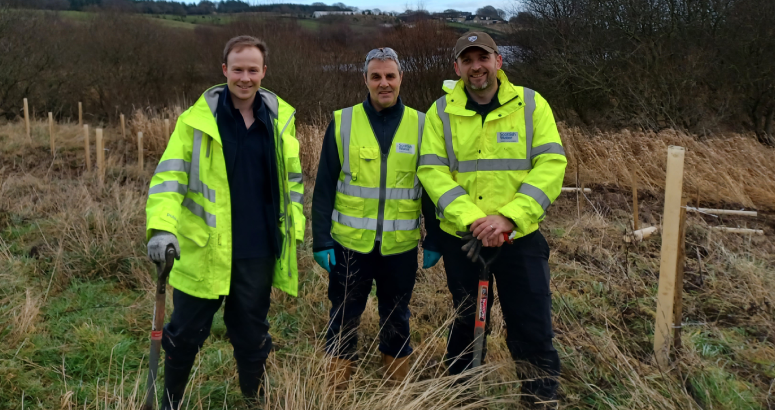Woodland Creation 2024/25
Project Overview
Our woodland creation programme has seen 20 schemes delivered across the country for 2024/25.Stretching from Clunas Reservoir in the Highlands, to Loch Whinyeon in Dumfries and Galloway, over 180 hectares of new native woodland has been created on Scottish Water land.
This year’s programme has been significantly expanded, and over the 2024/25 planting season we have planted almost three times the amount of new woodland as we did the previous year.

Working in partnership
We have worked alongside community groups and Scottish Water volunteers to plant a number of our 'Wee Woodland' sites.
What We Are Doing
We are creating new native woodlands made up of oak, alder, hawthorn, rowan and birch trees on Scottish Water land.
In addition to our larger woodland sites we are now also creating small 0.5 - 1 hectare 'Wee Woodlands' in our water catchments. As well as providing water quality and carbon benefits, these Wee Woodlands support community needs and green biodiversity corridor creation, and we worked with community groups Friends of the Pentlands and Fife Coast and Countryside Trust (FCCT) alongside Scottish Water volunteers last year to create a number of these.
This year we have also started trialling the use of innovative fungal pellets at a number of sites which aim to produce more resilient forests, increase carbon capture potential and reduce the need for fertiliser.
The Rhizopellets create a symbiotic underground nutrient network that helps both trees and fungi to flourish and will be monitored against the growth of trees planted without them.
More woodland creation schemes are also being planned for future years, as part of Scottish Water’s response to the climate and biodiversity crises and the drive to reach net zero emissions by 2040.
Breakdown of the projects delivered as part of the woodland creation programme this year:
Acreknowe Reservoir - 0.50 hectares planted (Scottish Borders)
Arnot Reservoir - 0.92 hectares planted (Perth and Kinross)
Auchengaich Reservoir - 1.52 hectares planted (Argyll and Bute)
Backwater Reservoir - 45.14 hectares planted (Angus)
Clunas Reservoir - 1.14 hectares planted (Highland)
Dunside & Dunside Water Treatment Works - 10 hectares planted (South Lanarkshire)
Glenkiln Reservoir - 1.69 hectares planted (Dumfries and Galloway)
Glencorse Reservoir - 0.50 hectares planted (Midlothian)
Glengavel Reservoir – 28.9 hectares planted (South Lanarkshire)
Helensburgh Reservoir No.2 - 2.47 hectares planted (Argyll and Bute)
Knockquhassan Reservoir - 1.86 hectares planted (South Ayrshire)
Loch Whinyeon – 1.76 hectares planted (Dumfries and Galloway)
Megget Reservoir - 2.77 hectares planted (Scottish Borders)
Middle Coul - 3.57 hectares planted (East Dunbartonshire)
Newton Mearns - 1.96 hectares planted (East Renfrewshire)
Newton of Lintrathen - 42.61 hectares planted (Angus)
Purdomstone Reservoir – 3.83 hectares planted (Dumfries and Galloway)
Pitewan – 22.63 hectares planted (Angus)
Roscobie Reservoir - 1.02 hectares planted (Fife)
Talla Reservoir - 9.49 hectares planted (Scottish Borders)
Why We Are Doing It
The woodland creation programme aims to protect source water quality at these locations by helping to stabilise the soil and prevent organic material being washed into the reservoirs and lochs during heavy rainfall.
This means the treatment process to maintain high quality drinking water for customers is less complex, requiring less energy and chemicals than source water that has high levels of organic material in it.
Through the schemes, we also look to improve biodiversity at these sites while locking up carbon. Cumulatively, the 20 schemes completed over 2024/25 will offset 1,575 tonnes of carbon dioxide equivalent annually and 96,550 tonnes over the next 60 years - the equivalent of around 50,816 round-trip flights between Glasgow and New York.
This is key to helping us meet our net zero targets by 2040.






